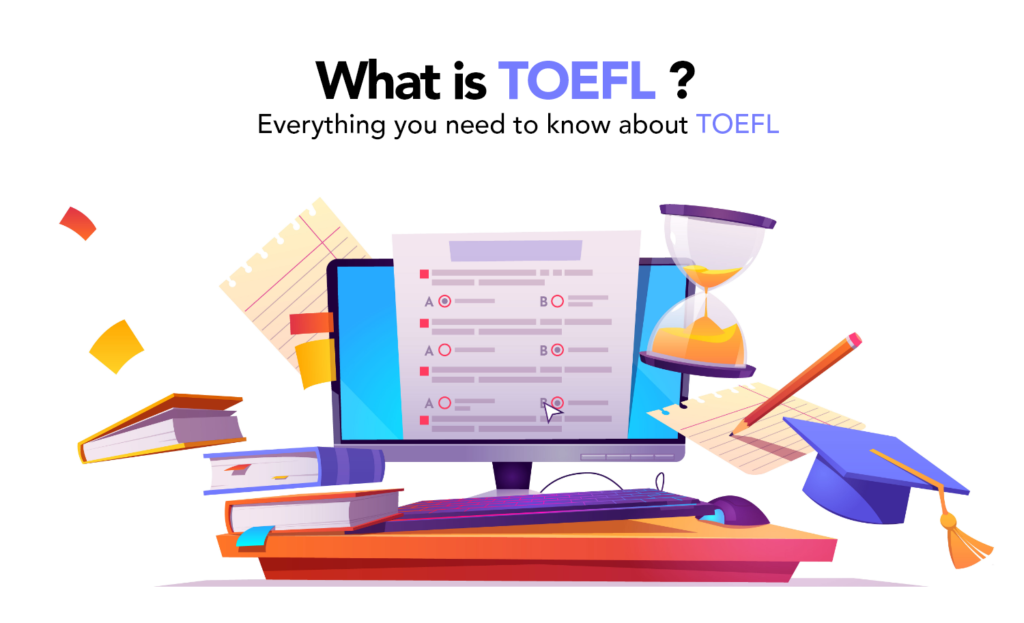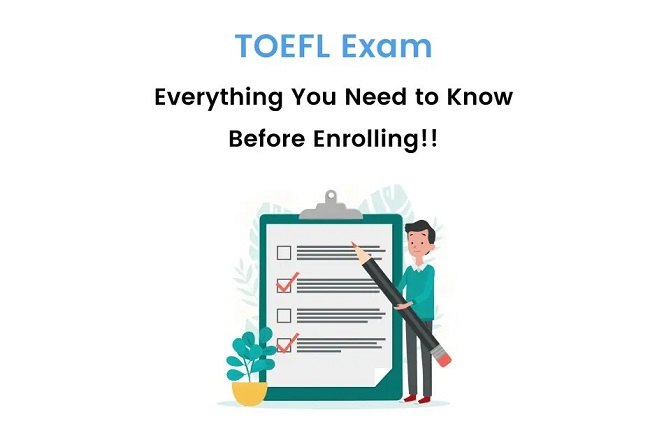Are you looking to expand your educational horizons or advance your career on a global scale with TOEFL? Today proficiency in English is often a prerequisite. The Test of English as a Foreign Language (TOEFL) serves as a gateway to international academic and professional opportunities. This guide provides you with a comprehensive understanding of everything you need to know about TOEFL, from its format and scoring to effective preparation strategies.

What is TOEFL?
TOEFL, or the Test of English as a Foreign Language, is an internationally recognized standardized test that assesses the English language proficiency of non-native English speakers. It is designed to evaluate a person’s ability to understand and use English in an academic and professional setting. TOEFL scores are commonly used by universities, colleges, and employers around the world to make admissions and hiring decisions, as they provide insights into an individual’s ability to read, write, speak, and comprehend English
TOEFL iBT vs. TOEFL PBT
TOEFL, or the Test of English as a Foreign Language, is available in two primary formats: TOEFL iBT (Internet-based Test) and TOEFL PBT (Paper-based Test). These formats are designed to assess English language proficiency in slightly different ways, and the choice between them depends on various factors, including the location of the test center and the preferences of test-takers. Here’s a comparison of TOEFL iBT and TOEFL PBT:
TOEFL iBT (Internet-based Test):
- Test Format: TOEFL iBT is delivered online and consists of four sections: Reading, Listening, Speaking, and Writing. It is taken on a computer at authorized test centers equipped with the necessary technology.
- Speaking Section: The TOEFL iBT includes a Speaking section where test-takers speak into a microphone, and their responses are recorded. This section assesses the ability to convey spoken English effectively.
- Writing Section: The Writing section on TOEFL iBT requires typing responses on a computer, evaluating the test-taker’s ability to write coherently in English.
- Accessibility: TOEFL iBT is widely accessible, as it is offered in many locations worldwide. It is the most common format and is accepted by most universities and institutions.
- Scoring: Scores for each section range from 0 to 30, with a maximum total score of 120.
TOEFL PBT (Paper-based Test):
- Test Format: TOEFL PBT is administered in a paper-and-pencil format. It includes three sections: Listening Comprehension, Structure and Written Expression, and Reading Comprehension.
- No Speaking Section: Unlike TOEFL iBT, TOEFL PBT does not include a Speaking section, so it does not assess spoken English.
- Writing Section: The Writing section in TOEFL PBT evaluates test-takers’ ability to construct written English, including grammar and structure.
- Accessibility: TOEFL PBT is less commonly offered and has become less prevalent in recent years. It may still be administered in regions where the internet-based format is less accessible.
- Scoring: Scores for each section are on a scale of 31 to 68, and the total score ranges from 310 to 677.
Choosing Between TOEFL iBT and TOEFL PBT:
- Test-takers should consider the format of the test center in their location. In some regions, TOEFL iBT may be the only available option.
- It’s important to check the specific requirements of the institution or organization you are applying to. Many universities and employers accept both formats, but some may have a preference for one or the other.
- TOEFL iBT assesses speaking and typing skills, which may better reflect real-world communication needs, especially for academic purposes. It’s a more comprehensive test in this regard.
- TOEFL PBT may be more suitable for individuals who are more comfortable with a paper-based test or who are in regions where the internet-based format is not readily available.

TOEFL Sections (Reading, Listening, Speaking, Writing)
1. Reading Section
The Reading section of the TOEFL measures a test-taker’s ability to comprehend written English, much like what they would encounter in an academic environment. This section includes passages from a variety of sources, such as textbooks, articles, and essays. Test-takers are evaluated on their capacity to:
- Comprehend main ideas, details, and inferences from the text.
- Identify the organization of a passage, including the author’s purpose and structure.
- Understand vocabulary and word meaning in context.
Format:
- Typically, there are three or four reading passages, and each passage is followed by a set of questions.
- Test-takers have approximately 20 minutes to answer questions related to each passage.
2. Listening Section
The Listening section assesses a test-taker’s ability to understand spoken English in academic and everyday contexts. It evaluates the capacity to:
- Comprehend main ideas, details, and the speaker’s purpose.
- Identify the organization and structure of the listening material.
- Recognize attitude, tone, and the speaker’s stance on the topic.
Format:
- The Listening section includes a series of audio recordings, including lectures, conversations, and discussions.
- Test-takers are required to answer questions based on what they hear.
3. Speaking Section
The Speaking section of TOEFL examines a test-taker’s ability to express themselves verbally in English. This section evaluates the capacity to:
- Clearly convey ideas and opinions.
- Effectively speak on topics related to academic or everyday situations.
- Organize spoken responses coherently.
Format:
- The Speaking section consists of six tasks, including independent and integrated speaking tasks.
- Independent tasks require test-takers to express their opinion on a specific topic.
- Integrated tasks involve listening to a conversation or lecture and then responding orally.
4. Writing Section
The Writing section assesses a test-taker’s ability to construct well-structured written responses in English. It evaluates the capacity to:
- Convey ideas and arguments in writing.
- Develop and support written responses effectively.
- Demonstrate proper grammar and vocabulary usage.
Format:
- The Writing section includes two tasks: an Integrated Writing task and an Independent Writing task.
- In the Integrated task, test-takers read a passage and listen to a lecture, then write a response.
- In the Independent task, test-takers express their opinion on a specific topic.
Scoring in TOEFL
TOEFL iBT Scoring
The TOEFL iBT is the most widely used format and is known for its comprehensive assessment of English language skills. The total TOEFL iBT score ranges from 0 to 120, with each of the four sections scored separately.
Here’s how it’s broken down:
- Reading Section (0-30 Points): The Reading section consists of multiple-choice questions and measures your ability to understand written English. Your score in this section is reported on a scale of 0 to 30.
- Listening Section (0-30 Points): Similar to the Reading section, the Listening section contains multiple-choice questions assessing your ability to understand spoken English. Your score in this section is also reported on a scale of 0 to 30.
- Speaking Section (0-30 Points): The Speaking section assesses your ability to express yourself verbally in English. It includes six tasks and is scored on a scale of 0 to 30, with each task receiving a score from 0 to 4.
- Writing Section (0-30 Points): The Writing section evaluates your written communication skills. It also includes two tasks and is scored on a scale of 0 to 30, with each task receiving a score from 0 to 5.
These four section scores are then added together to calculate your total TOEFL iBT score. The maximum total score you can achieve is 120.
TOEFL PBT Scoring
The TOEFL PBT is administered in a paper-and-pencil format and assesses reading, listening, and writing skills (as the Speaking section is not included in the PBT). The scoring system for TOEFL PBT is different from the TOEFL iBT:
- Listening Comprehension (31-68 Points): This section evaluates your ability to understand spoken English. The score for the Listening Comprehension section ranges from 31 to 68.
- Structure and Written Expression (31-68 Points): This section measures your knowledge of English grammar and sentence structure. The score for Structure and Written Expression also ranges from 31 to 68.
- Reading Comprehension (31-68 Points): The Reading Comprehension section assesses your ability to understand written English. Like the previous sections, the score ranges from 31 to 68.
These three section scores are then added together, and the total TOEFL PBT score ranges from 310 to 677.
What Do Test Results Mean?
120 Points (Advanced/Proficiency – C1-C2)
Achieving a score of 100 to 120 indicates an advanced or proficient level of English proficiency, typically falling within the C1 to C2 range on the Common European Framework of Reference for Languages (CEFR). This level of proficiency is considered near-native or native-like and demonstrates a high command of the English language. A score of 120 is often the highest possible result and testament to exceptional language skills.
75-95 Points (Upper-Intermediate – B2)
Scoring between 75 and 95 signifies an upper-intermediate level of English proficiency, equivalent to level B2 on the CEFR. This level of proficiency is usually sufficient for admission to most foreign universities, though specific admission requirements may vary by institution. It reflects a strong ability to communicate in English in academic and professional settings.
60-70 Points (Intermediate – B1)
A score ranging from 60 to 70 corresponds to an intermediate level of English proficiency, aligning with level B1 on the CEFR. This level is suitable for completing preparatory courses at universities and studying at some professional colleges. It reflects the ability to handle everyday communication in English and demonstrates foundational language skills.
Less Than 60 Points (Pre-Intermediate and Below)
Scoring below 60 points places a test-taker at the pre-intermediate level or lower on the CEFR scale. English proficiency is limited at this level, and there will be minimal benefit from this certificate in academic or professional contexts. Individuals with scores in this range typically require further language development to reach higher proficiency levels.
TOEFL Preparation Tips
1. Understand the TOEFL Format
Familiarize yourself with the TOEFL’s structure, including the four main sections: Reading, Listening, Speaking, and Writing. Knowing the format and the types of questions you’ll encounter can help reduce test-day anxiety.
2. Build Strong Language Skills
Focus on improving your overall English language skills. Read academic texts, listen to English podcasts or news broadcasts, engage in English conversations, and write essays. This practice will enhance your proficiency across all sections.
3. Practice Regularly
Consistent practice is key. Utilize official TOEFL preparation materials, such as sample test papers and online resources, to simulate test conditions. Regular practice will help you manage time effectively and improve your test-taking skills.
4. Develop Time Management Skills
The TOEFL is timed, so it’s essential to allocate your time wisely during each section. Practice answering questions within the given time limits to ensure you can complete the test successfully.
5. Take Sample Tests
Consider taking full-length practice tests to evaluate your progress and identify areas where you may need improvement. These tests can also help you get used to the test’s format and develop effective test-taking strategies.
Need help with IELTS then click here.

